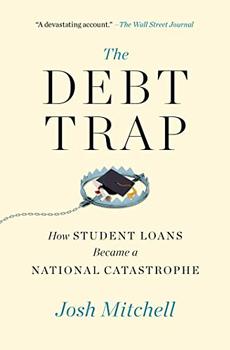Summary | Excerpt | Reviews | Beyond the Book | Readalikes | Genres & Themes | Author Bio

Critics' Opinion:
Readers' Opinion:
First Published:
Aug 2021, 272 pages
Paperback:
Aug 2022, 272 pages
 Book Reviewed by:
Book Reviewed by:
Eddie Bennett
Buy This Book
I don't think they're going to accept that, Lohr said.
I don't care, she replied. She was done living under the cloud of student debt.
She logged into her Vanguard account, snapped a screenshot of the balance—$12,086.43—and emailed it to him. It was all she had. And it was all the government was going to get out of her, she said.
How could this happen?
Millions of Americans have asked themselves Lisa's question. Today, 43 million people owe $1.6 trillion in student debt, an amount that has tripled since 2006. Americans owe more in student debt than they owe in credit card debt and car loans. Combined, student debt in the U.S. is the size of Canada's economy.
The program began with good intentions, as a way to pry open the gates to America's respected universities. By the late 20th century higher education had become intertwined with the American experience. It embodied the nation's promise of upward mobility: If you could get into college and worked hard enough while there, you were guaranteed a lifetime of success. For millions of Americans—poor and middle-class, fifth-generation and new immigrants alike—college was the first step on the ladder to prosperity in the world's biggest and most dynamic economy.
Elected leaders wanted to give every American the chance at that prosperity by removing the financial barrier to college and graduate school. They did so by providing loans, combining the American ideals of education, upward mobility, and individual responsibility. Americans would be guaranteed a shot at the American Dream—while paying their own way, without a handout.
Families put their faith in institutions—Congress, banks, universities— as they signed up for loans. They assumed those institutions had their best interests at heart. Students thought they were making an investment, and in fact they were told they had no choice. Radical shifts in the U.S. economy placed growing emphasis on the need for a degree to succeed. College wasn't a luxury but an economic imperative.
For too many, that investment has gone bust.
Far from making college more affordable, student debt enabled schools to raise tuition faster than family incomes, creating a higher- education industrial complex that has driven up the price of college and graduate school to unprecedented levels. Average tuition and room and board at four-year private colleges has risen nearly 800 percent since 1980, more than five times the rate of inflation. Today a four-year degree at a private college costs nearly $200,000 on average, before discounts. The same degree at a public college costs more than $100,000 on average. Scholarships and grants bring the price down for many students, but the average obscures massive problems.
A substantial and growing share of students pays far more than the average and gets into tens of thousands of dollars—and in some cases hundreds of thousands of dollars—in debt just for a shot at making it in today's economy. At the University of Alabama, a state flagship profiled in this book, most students come from out of state and pay $45,000 per year, or $180,000 over four. Even after grants and scholarships are factored in, many Alabama students and their parents take on tens of thousands of dollars in debt, and in some cases more than $100,000.
Then there's graduate school—including medical and law school—which accounts for nearly 40 percent of all student debt in the U.S. Taking on six figures of student debt for grad school has become routine. At the University of Southern California's dental school, tuition and room and board cost $152,000—for the first year.
Student debt is both a cause and consequence of those higher costs. The government gives families a blank check to allow students to attend the school of their choice, regardless of that school's price. Colleges have abused their tremendous pricing power. This is the never-ending chase of college pricing: The more colleges raise tuition, the more Americans borrow. The more Americans borrow, the more colleges raise tuition. More than two-thirds of undergraduates borrow, and those who do graduate owing an average of $29,000. Those with larger balances are among the fastest-growing groups, even accounting for inflation. A generation ago it was rare to owe $60,000 in student debt; now more than seven million Americans owe that much. A million borrowers owe more than $200,000. At least a hundred owe over $1 million.
Excerpted from The Debt Trap by Josh Mitchell. Copyright © 2021 by Josh Mitchell. Excerpted by permission of Simon & Schuster. All rights reserved. No part of this excerpt may be reproduced or reprinted without permission in writing from the publisher.





The House on Biscayne Bay
by Chanel Cleeton
As death stalks a gothic mansion in Miami, the lives of two women intertwine as the past and present collide.

The Flower Sisters
by Michelle Collins Anderson
From the new Fannie Flagg of the Ozarks, a richly-woven story of family, forgiveness, and reinvention.

The Funeral Cryer by Wenyan Lu
Debut novelist Wenyan Lu brings us this witty yet profound story about one woman's midlife reawakening in contemporary rural China.
Your guide toexceptional books
BookBrowse seeks out and recommends the best in contemporary fiction and nonfiction—books that not only engage and entertain but also deepen our understanding of ourselves and the world around us.